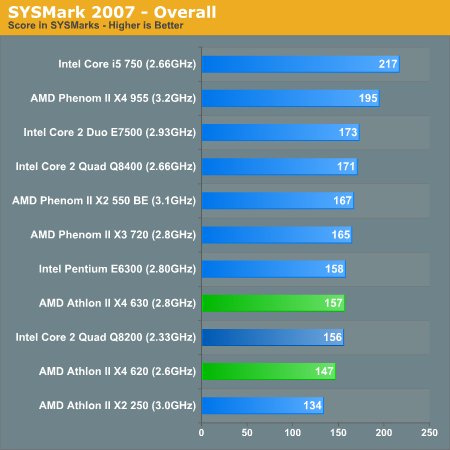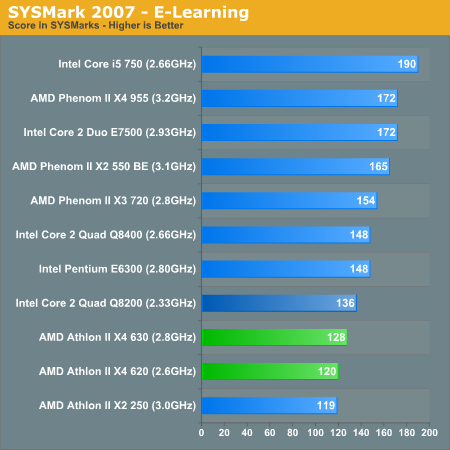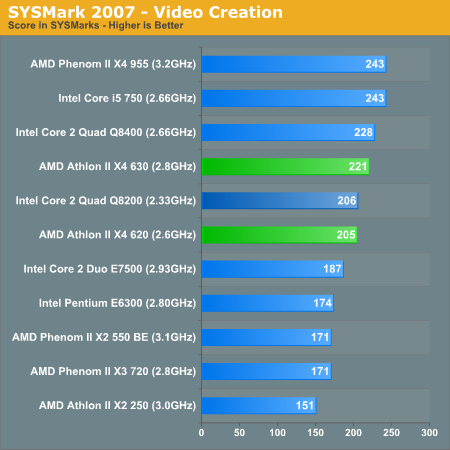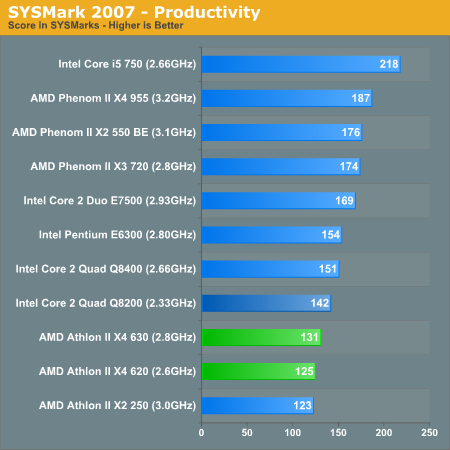AMD Athlon II X4 620 & 630: The First $99 Quad Core CPU
by Anand Lal Shimpi on September 16, 2009 12:00 AM EST- Posted in
- CPUs
SYSMark 2007 Performance
Our journey starts with SYSMark 2007, the only all-encompassing performance suite in our review today. The idea here is simple: one benchmark to indicate the overall performance of your machine.

If we only look at the AMD numbers in this chart, there's a pretty nice lineup going on here. The Athlon II X2 250 is slower than the Athlon II X4 620/630, which is slower than the Phenom II X3 730 and all are slower than the Phenom II X4 955. The performance lines up with the pricing, so all is good.
The problem with these cheap quad-cores has always been that you give up a lot in order to get four cores at a low price. The Athlon II X4 appears to break the mold however. The Athlon II X4 620 is priced at $99 and it performs like a $99 CPU. With the exception of the Core 2 Duo E7500 whose high clock speed makes it do unsually well here, the 620 is balanced. You get a reasonably high clock speed and enough cache to be competitive, both at a good price.
You'll see in the individual tests below that performance varies between competitive and underwhelming depending on the task. Anything that can take advantage of four cores does well, otherwise the smaller L2s of the Athlon II X4 hurt it a bit.

In applications that aren't well threaded, you'll see the Athlon II X4 perform less than stellar - but the same is true for all lower end quad-core CPUs. Even the Q8200 is outperformed by the E6300 here. Situations like this are validation for Intel's aggressive turbo modes on Lynnfield.

Any strenuous video encoding however will seriously favor the Athlon II X4. Here we find the $99 620 tying the Core 2 Quad Q8200, and the 630 outperforming it - all at a lower price.

We're back to needing higher clock speeds and larger caches to compete. Being a quad-core processor isn't easy.











150 Comments
View All Comments
fitten - Wednesday, September 16, 2009 - link
Your definition of "overclocked" is flawed. Back under the bridge with you!philosofa - Wednesday, September 16, 2009 - link
Can someone please ban this moron, and the others (who ironically I assume are on AMD's payroll?). Their lack of an understanding of the most basic logic is making me feel ill.Good Review though, just really want Bulldozer to come out!
james jwb - Thursday, September 17, 2009 - link
why can't people like you understand what is meant? I can handle my own CPU, so for me, i want to know which one is better clock for clock, and then see what the average each overclock to, then i'll jump in and buy one.The way data is currently being presented here isn't right, we need both ways (stock results with turbo on, and clock for clock style stuff for us overclockers).
Get it now? Probably not.
bupkus - Wednesday, September 16, 2009 - link
"Their lack of an understanding of the most basic logic is making me feel ill."Take a Tums; we're not interested.
rennya - Wednesday, September 16, 2009 - link
Overclocking is not the same as turbo mode.Overclocking voids your warranty, whether you use Intel or AMD CPUs.
Turbo mode doesn't void warranty because it is a valid feature.
SlyNine - Wednesday, September 16, 2009 - link
lol You will make your own little universe in your mind. okay lol.Overclocking. Lets see. Over, meaning above normal. Well since the post turbo mode clock is perfectly normal. Its not OVER clocking.
vol7ron - Wednesday, September 16, 2009 - link
Just because the clock rate is variable, does not mean it's [over/under]clocking. It just means the speeds change. In fact, even when you are running at stock speeds, the clock rate will vary - that is why you see 3.541 3.500 3.489To complain it's not a fair comparison, he's kind of right, but not for the right reason. It's as if he's in AMDs defense, rather than their scrutiny. Instead of comparing peaches-to-peaches, now you're comparing nectarines-to-peaches and there's two ways to look as this glass: Intel is turbo-ing during fewer threads, or Intel is decelerating in multithreaded situations; both have the same effect. (They're either trying to give you more bang for the buck, or they put out a bad product that only works half the time)
The end result, though, AMD doesn't do this on the fly. Sure you could test it at different clock speeds, but you could also overclock the i7 to something faster (and you might be back at square one).
Chlorus - Wednesday, September 16, 2009 - link
"remember that the lynnfield core i7 750 has turbo overclocking enabled so is overclocked to 3.2 ghz, which is 600 mhz overclocking, while amd processors are running at stock speedIs unfair to present the results this way, turbo is overclocking. "
Its not overclocking if ITS ON BY DEFAULT, you worthless troll.
hanhan1982923 - Wednesday, April 14, 2010 - link
22222222222222Thomas369 - Saturday, July 28, 2018 - link
The Athlon architecture also used the EV6 bus licensed from DEC as its main system bus. Intel required licensing to use the GTL+ bus used by its Slot 1 Pentium II and later processors. By licensing the EV6 bus used by the Alpha line of processors from DEC, AMD was able to develop its own chipsets and motherboards, and avoid being dependent on licensing from its direct competitor. https://chasebanklogin.us/chase-credit-card-login/